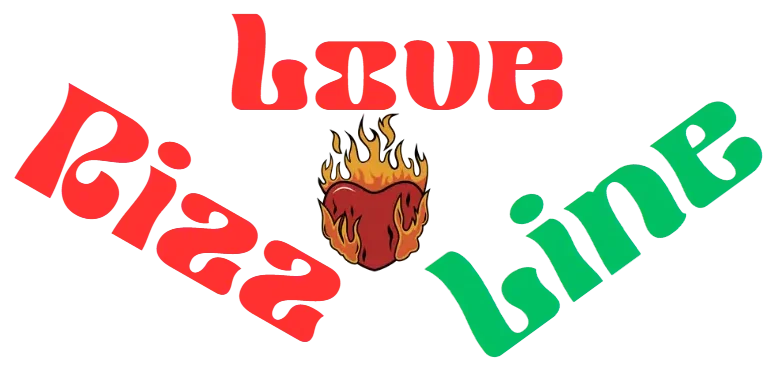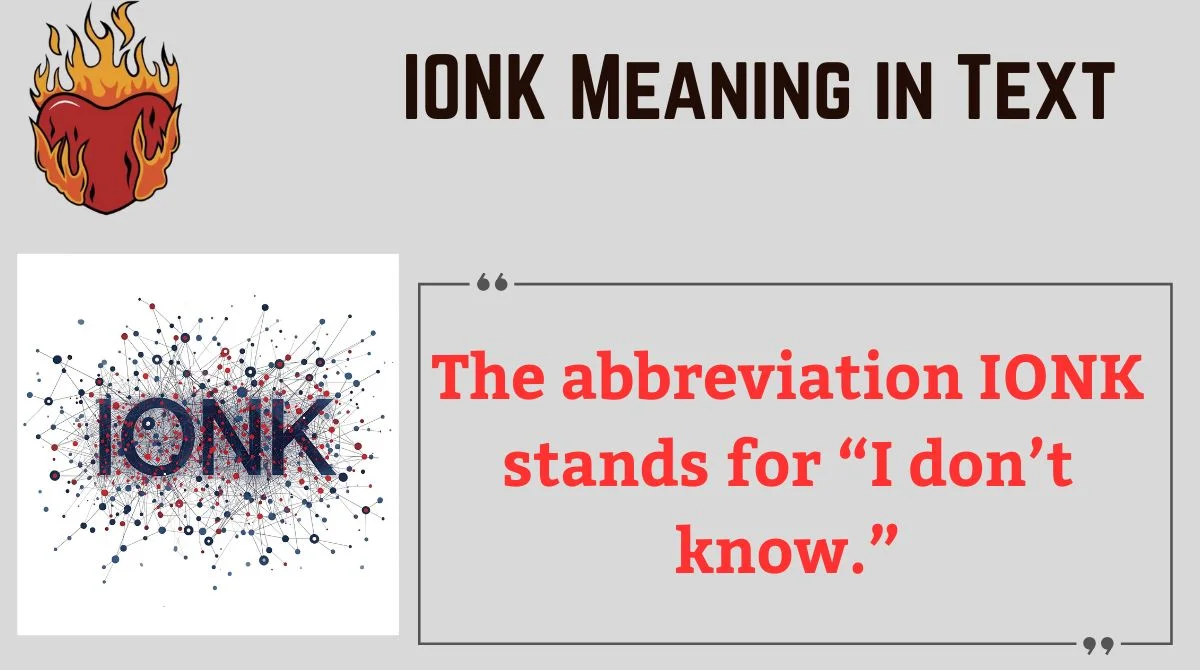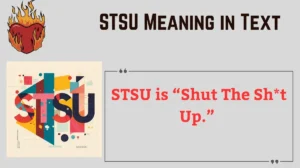Digital conversations move fast, and slang evolves even faster. One moment everyone’s typing “IDK,” and the next, a new abbreviation takes over your DMs.
One of those trending terms is “IONK.” If you’ve seen it pop up in texts, group chats, or even dating apps, you’re not alone.
This guide dives deep into the IONK meaning in text, its origin, real-world usage, cultural nuances, and how to respond to it naturally.
Whether you’re a casual texter or a social media power user, this article will make sure “IONK” never confuses you again.
What “IONK” Stands For: Clear Definition
The abbreviation IONK stands for “I don’t know.”
It’s a stylized, phonetic variation of IDK that mimics the way people say the phrase quickly in speech or casual text. Over time, this shorthand became common in online spaces, particularly among Gen Z and younger millennials.
Unlike “IDK,” which is neutral and direct, IONK often carries a softer or more playful tone. It can suggest uncertainty without sounding blunt.
Examples in Conversation:
- Friend 1: “What time is the party?”
Friend 2: “IonK, maybe around 8?” - Person A: “Do you like him?”
Person B: “IonK 😅”
👉 Notice how “IonK” here doesn’t feel stiff or dismissive. It feels casual, like you’re talking face-to-face.
Origins and Evolution of “IONK”
Slang like “IONK” doesn’t just appear out of nowhere. It’s part of a natural evolution of digital language.
- Early 2000s: Texting on T9 keypads made abbreviations essential (e.g., “brb,” “idk,” “ttyl”).
- 2010s: Social media platforms like Twitter and Snapchat pushed users toward short, punchy replies.
- 2020s: Spoken internet culture—driven by TikTok, memes, and live-streaming—popularized phonetic texting like “ion” (for “I don’t”) and “ionk” (for “I don’t know”).
The key difference between “IDK” and “IONK” is sound. It reflects how people actually pronounce the phrase in quick speech. Over time, this phonetic realism made it popular with younger users who prefer their texts to feel natural.
Fun fact: According to informal surveys in online communities, IONK is most used among users between 15–29 years old, especially on platforms like Snapchat and TikTok.
Real-World Usage in Different Contexts
The beauty of “IONK” lies in its flexibility. It’s short, casual, and fits into almost any conversation—though tone matters a lot.
Casual Texting
In everyday conversations between friends or peers, “IONK” often means genuine uncertainty.
Examples:
- “IonK what to wear 😭”
- “IonK bro, I just got here.”
This usage is relaxed, sometimes humorous, and rarely confrontational.
Social Media
On Twitter/X or TikTok, “IONK” often appears in replies, captions, or comment threads.
- “IonK why this song hits so hard 😭🔥”
- “IonK what y’all on about 💀”
Here, it’s playful and expressive, not formal at all.
Dating Apps
“IONK” can carry subtle meaning on dating apps like Bumble or Tinder.
- “IonK maybe we should just grab a coffee ☕”
- “IonK, I’m kinda shy 😅”
In this context, it softens statements—a way to sound approachable, uncertain but open.
Gaming & Livestream Chats
In fast-paced environments, “IONK” is about speed.
- “IonK where the loot is”
- “IonK bro, I didn’t see him.”
It’s direct and efficient, helping players communicate without slowing down.
Tone and Intent: What It Really Communicates
“IONK” isn’t just about what it means but how it’s said. The same word can sound shy, sarcastic, or indifferent depending on tone, emojis, and context.
| Context | Tone | Example | Meaning |
|---|---|---|---|
| Casual | Uncertain, playful | “IonK 😅” | Unsure but lighthearted |
| Sarcastic | Teasing | “IonK 🙄” | Knows the answer but being ironic |
| Indifferent | Neutral | “IonK.” | Doesn’t care much or checked out |
| Defensive | Evasive | “IonK why she said that” | Avoiding direct answer |
👉 Tip: Watch for emoji use, punctuation, and timing. “IonK.” with a period can sound colder than “IonK 😭” with a laughing-crying emoji.
Common Misconceptions and Real Clarifications
Despite its popularity, “IONK” often gets misunderstood.
Myth 1: It’s a different acronym.
Some confuse “IONK” with “ION” (I don’t) or other unrelated abbreviations. It’s not a brand, a code, or a hidden phrase. It simply means “I don’t know.”
Myth 2: It’s always sarcastic.
Not true. In fact, most uses are neutral or playful. Sarcasm depends on tone, not the word itself.
Myth 3: It’s rude.
“IONK” can sound blunt if sent alone, but in most cases, it’s harmless. Adding softeners like “idk lol” or emojis helps clarify intent.
IONK vs Similar Terms: A Quick Comparison Table
Many abbreviations overlap in meaning but differ in tone, platform, and usage. Here’s a side-by-side look.
| Term | Meaning | Tone | Typical Use | Platforms |
|---|---|---|---|---|
| IONK | I don’t know | Casual, playful, uncertain | Texting, chatting | TikTok, Snapchat, IG |
| IDK | I don’t know | Neutral | All contexts | All platforms |
| IDC | I don’t care | Dismissive | Informal convos | Snapchat, SMS |
| ION | I don’t | Casual, trendy | Gen Z texting | TikTok, IG |
👉 Why “IONK” stands out: It feels less robotic than “IDK.” It mirrors how people actually speak.
How to Respond When Someone Texts “IONK”
How you reply depends on what you want the conversation to be. Responding well can keep the flow natural and engaging.
If the tone is casual
- “Haha same 😂”
- “We’ll figure it out.”
If the tone is uncertain
- “Wanna guess anyway?”
- “That’s okay, we’ll find out later.”
If the tone is sarcastic or dismissive
- “Lol sure you don’t 😏”
- “Uh-huh.”
If you want to keep things light and playful
- “Typical answer 😎”
- “You never know anything 😭”
👉 Pro tip: If someone uses “IONK” in dating or flirty conversations, respond with humor or warmth, not interrogation. Tone sets the pace.
Regional, Cultural, and Generational Variations
Language isn’t static. “IONK” means the same thing globally, but how it’s used and received can shift.
- United States & Canada: Heavy use among younger people, especially on Snapchat and TikTok. Seen as fun, informal slang.
- UK: Used but slightly less common; IDK still dominates.
- Asia (especially Philippines, India, Pakistan): Popular among English-speaking youth online, often mixed with other slang.
- Older generations (35+): Many don’t use it actively but may recognize it if exposed through children or social media.
Quote from a 2023 teen slang study:
“Phonetic texting like IONK is less about speed now and more about sounding like real speech in online conversation.”
Potential Hidden or Offensive Interpretations
While IONK itself isn’t offensive, misunderstanding tone can create issues.
Potential problems:
- Seen as dismissive if sent alone without context.
- Misread as “I don’t care” in tense conversations.
- Could be ignored in formal settings.
How to avoid misinterpretation:
- Add emojis, punctuation, or follow-up messages.
- Read the room—if the conversation is serious, say the full phrase (“I’m not sure”).
IONK in Professional or Formal Settings
Never use IONK in professional emails, interviews, or client conversations. It may come across as immature or careless.
Instead, try:
- “I’m not sure, but I’ll check.”
- “Let me confirm that and get back to you.”
- “I don’t have that information right now.”
👉 Remember: Professionalism requires clarity. Slang belongs in casual spaces, not business communication.
FAQs About “IONK”
What does “IONK” stand for?
It stands for “I don’t know.” It’s a phonetic, casual version of “IDK.”
Is “IONK” the same as “IDK”?
Almost, but not exactly. “IONK” sounds more casual and mirrors spoken language.
Is “IONK” rude?
Not usually. But tone matters. Using it alone without context can sound indifferent.
Should I use “IONK” at work?
No. Use full phrases in professional settings to avoid sounding careless.
How can I make “IONK” sound friendly?
Add emojis or soft phrases, like “IonK 😅” or “IonK honestly.”
Conclusion
Digital language is alive—it shifts with trends, technology, and how we speak. “IONK” reflects this shift perfectly.
It’s short, playful, and human. It bridges the gap between spoken language and text, letting people express uncertainty without sounding stiff.
But like all slang, context is everything. Use “IONK” with friends, in casual chats, or on social media—but avoid it in formal settings. The more you understand the tone, the better you’ll communicate in the digital world.

Mark Peter is the creative mind behind RizzleLineLove.com, your go-to hub for witty, flirty, and downright hilarious pick-up lines. With a passion for blending humor and charm, Mark crafts content that sparks conversations, breaks the ice, and adds a playful twist to everyday moments.
Whether you’re looking to impress your crush, make your friends laugh, or spice up your social media captions, his work is all about helping you connect — one clever line at a time.



